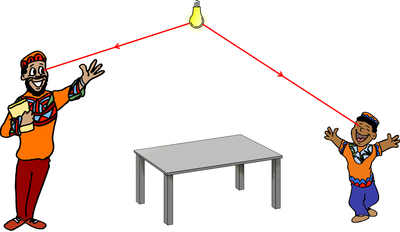Contents
Key Stage 2
Meaning
Light is what we can see with our eyes and dark is when there is not enough light to see things clearly.
About Light and Dark
- Light can be very bright or it can be very dark.
- When light is very bright it can hurt our eyes. Light from The Sun is very bright and we shouldn't look at The Sun because it can cause people to go blind.
- When there is not enough light to see we say it is dark. At night time it is very dark which is why it is hard to see.
| No-one can see because there is no light so the room is dark. | The man can see the light bulb because light from the bulb goes into the man's eyes. The boy cannot see the light bulb because his eyes are closed. |
Key Stage 3
Meaning
Light is a wave that transfers energy and information.
About Light
- Light is a transverse wave.
- Light can travel through a vacuum as well as through any transparent solid, liquid, gas.
- The speed of light through a vacuum is 300,000,000m/s.
- Transmitted - Light can pass through a medium.
- Absorbed - The energy transferred by light can be taken in by an opaque material.
- Reflected - Light can bounce off a surface. This can be either Diffuse Reflection or Specular Reflection.
- Refracted - Light can change direction when it changes medium.
Medium
- Light can travel through a transparent medium but it does not need matter to travel through as it can pass through a vacuum.
- Light can travel through any transparent solid, liquid, gas.
- Light travels most quickly through a vacuum.
- Light travels most slowly through solids.
Colour
Light can be divided into 7 colours:
- Red
- Orange
- Yellow
- Green
- Blue
- Indigo
- Violet
Key Stage 4
Meaning
Visible light is an electromagnetic wave that humans can see.
About Light
Properties
- Visible light is a transverse wave.
- Visible light can travel through a vacuum as well as through any transparent solid, liquid, gas.
- The speed of visible light through a vacuum is 300,000,000m/s.
- Transmitted - Visible light can pass through a medium.
- Absorbed - The energy transferred by visible light can be taken in by an opaque material.
- Reflected - Visible light can bounce off the interface between two media. This can be either Diffuse Reflection or Specular Reflection.
- Refracted - Visible light can change direction when it crosses the interface between two media.
Colour
- Different frequencies of visible light are reflected or absorbed by different surfaces giving them colour.
Visible light can be divided into 7 colours:
- Red - The lowest frequency and longest wavelength of visible light.
- Orange
- Yellow
- Green
- Blue
- Indigo
- Violet - The highest frequency and shortest wavelength of visible light.
Applications
- Visible light is used for sight, photography, microscopy, telescopy because it can be seen with the human eye.
- Visible light can be used in fibre optic communication because it is not absorbed by the glass that the fibres are made from and it is reflected internally by the interface between the glass and the air.
Dangers
- There are no dangers of visible light, unless it is extremely intense in which case it could cause blindness.
Beyond the Curriculum
References
AQA
- Light year, page 274, GCSE Physics; Student Book, Collins, AQA
- Light, models of, page 336, GCSE Combined Science Trilogy 1, Hodder, AQA
- Light, pages 124, 126-127, 131, 154-157, 176-177, GCSE Biology; Third Edition, Oxford University Press, AQA
- Light, pages 192, 202-213, 238-239, GCSE Physics; Third Edition, Oxford University Press, AQA
- Light; red-shift, page 256, GCSE Physics, Hodder, AQA
- Light; reflection of, pages 188-90, 195, 197, GCSE Physics, Hodder, AQA
- Light; refraction of, pages 195-6, 198, GCSE Physics, Hodder, AQA
- Light; spectrum of, pages 207-8, GCSE Physics, Hodder, AQA
- Light; transmission and absorption of, pages 189-90, GCSE Physics, Hodder, AQA
- Light; uses and applications, page 200, GCSE Physics, Hodder, AQA

